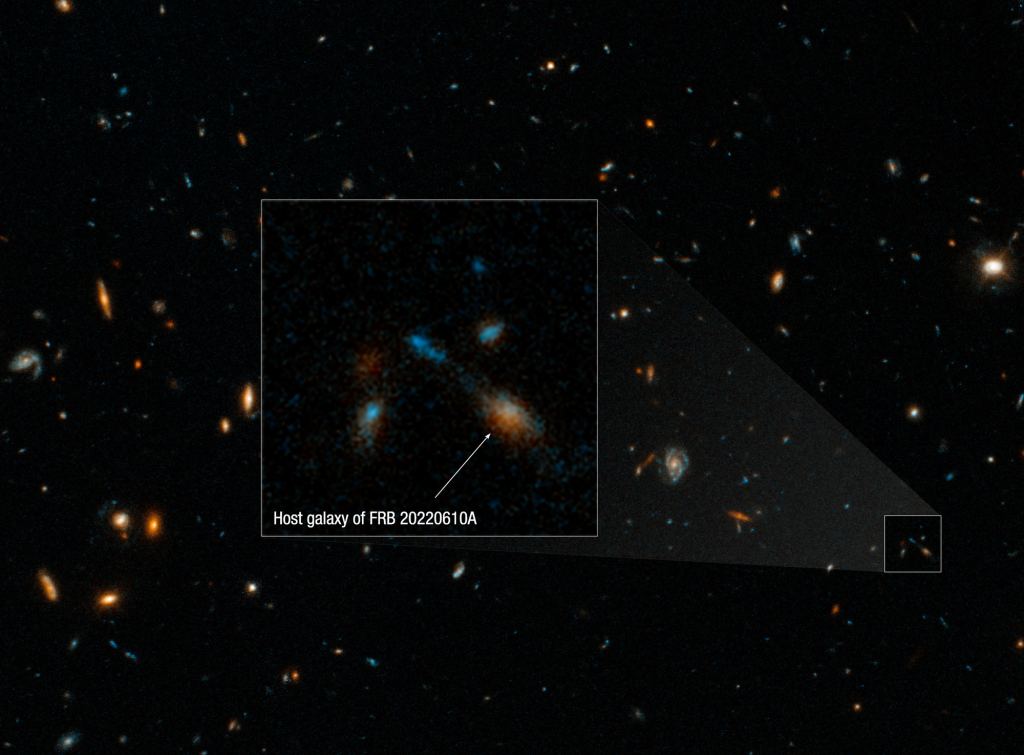Way back when the cosmos was only five billion years old, a powerful explosion happened in a group of young galaxies halfway across the Universe. It sent out a blast of radiation from one member of that distant galaxy group. On June 10, 2022, the Square Kilometer Array pathfinder telescope in Australia picked up a fast radio burst (FRB) emanating from the site.
The Very Large Telescope in Chile confirmed its distance. Now, Hubble Space Telescope provides a look at the specific galaxy where the FRB originated. It’s kinda weird.
Hubble’s view suggests that the event, called FRB 20220610A, happened in a galaxy-rich part of the Universe. That’s pretty unexpected since most FRBs happen in isolated galaxies, not necessarily in clusters. That alone makes this event a “weirdo” outlier in the annals of fast radio burst detections.
“It required Hubble’s keen sharpness and sensitivity to pinpoint exactly where the FRB came from,” said astronomer Alexa Gordon of Northwestern University in Evanston, Illinois. “Without Hubble’s imaging, it would still remain a mystery as to whether this was originating from one monolithic galaxy or some type of interacting system. It’s these types of environments – these weird ones – that are driving us toward better understanding the mystery of FRBs.
” A fast radio burst is just what it sounds like: a huge blast of radio waves, accompanied by a visible-light component. FRBs can outshine a galaxy for a very short time, which catches astronomers’ attention. They’ve been observed for decades and the first one was discovered in 2007.
Astronomers still aren’t sure exactly what sets them off. “We are ultimately trying to answer the questions: What causes them? What are their progenitors and what are their origins? The Hubble observations provide a spectacular view of the surprising types of environments that give rise to these mysterious events,” said co-investigator Wen-fai Fong, also of Northwestern University. Of course, there are a lot of theories about the origins of these events.
Black holes or neutron stars may play a role in creating these outbursts. An FRB may get stirred up in an intense neutron star called a magnetar. These objects exist in various “flavors”, so their FRBs might also have different aspects.
Magnetars have incredibly strong, twisted magnetic fields (hence the name magnetar). Sometimes those magnetic fields get so twisted that they break and reconnect. This happens on other stars and on the Sun, although not at the same intensity as a magnetar.
The whole process, from snap to reconnection releases a tremendous amount of energy. On a magnetar, the “snap” could be what generates the flash of light and release of radio waves that characterize a FRB. The heat released would vaporize any nearby material, such as gas and dust.
If a magnetar isn’t involved in every FRB, maybe black collisions play a role. Or, it’s possible that some interaction between a black hole and a massive object orbiting around it could cause one of these explosions. The merger of neutron stars could do it, too.
At least, those are two other theories to explain these blasts. Some astronomers also suggest that very energetic and huge supernova explosions might be enough to create an FRB. And, there are a variety of other ideas, involving black holes, pulsars, and dark matter.
To get to the root cause of FRBs, astronomers need to observe more of them at high resolution. As it is now, when the signals from one hit Earth, radio telescopes gather the first data. Then, once astronomers figure out the location, they send information to various ground-based and orbiting telescopes.
Those observatories can then focus on the other wavelengths of light coming from the explosion. Hubble Space Telescope plays a crucial role in delivering the sharpest possible images of the distant regions of space where FRBs occur. “We just need to keep finding more of these FRBs, both nearby and far away, and in all these different types of environments,” said Gordon.
In addition, astronomers want to know what are most likely environments for FRBs. Are most of them confined to individual, isolated galaxies? Or, can they occur in the galaxy cluster neighborhood? Also, since these events seem to occur at great distances, that means they happened early in cosmic history. The most distant one so far sent its light across 8 billion light-years to reach us .
What happened in their galaxies in those early epochs to spur on the incredible blasts of energy released? These and other questions await further observations of FRBs. Hubble Finds Weird Home of Farthest Fast Radio Burst A Fast Radio Burst in a Compact Galaxy Group at z~1.
From: universetoday
URL: https://www.universetoday.com/165185/hubble-shows-that-a-fast-radio-burst-came-from-a-giant-group-of-galaxies/



